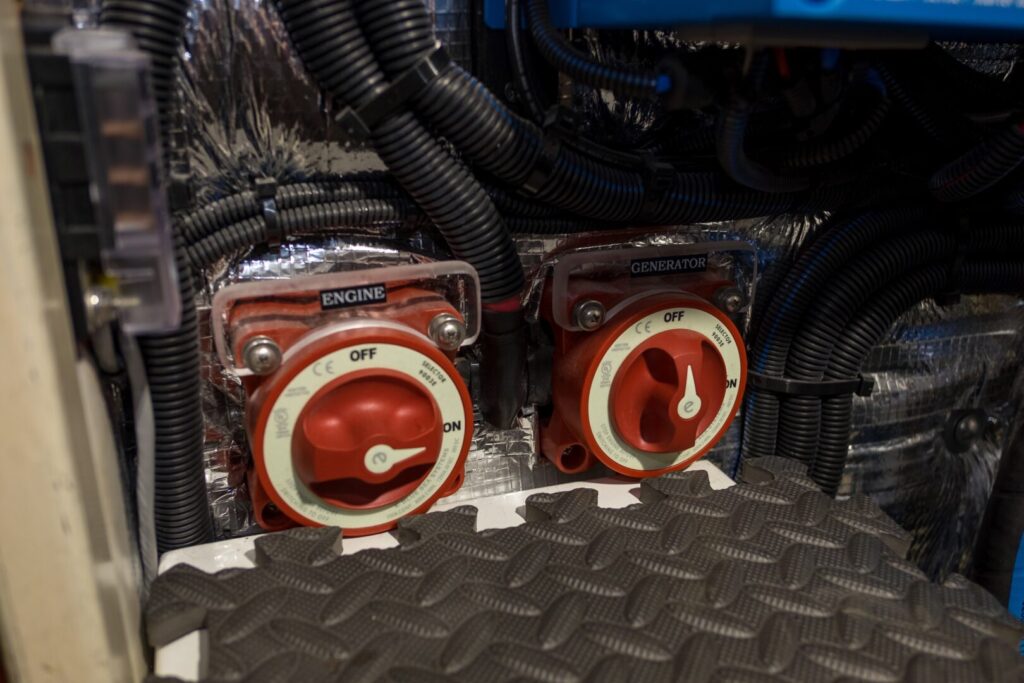
Let’s go over the basics of marine battery switches and why you should have one on your boat.
You’ve probably heard of a marine battery switch if you are setting up your new marine electrical system. Marine battery switches typically look like big red switches near your electrical controls. They usually connect to the heart of your electrical system. But what does a marine battery switch do? And is it essential to have one? Let’s go over the basics of marine battery switches and why you should have one on your boat.
What Does a Marine Battery Switch Do?
Any boat with more than one battery will usually have two battery banks – one to start the engine (the “start” battery bank) and another “house” bank to run any electrical appliances. When sitting at anchor, keeping these two battery banks separate is a good idea so you can still start your engine if you accidentally drain down the house bank.
A battery switch gives you complete control over which bank is being used or charged. Some marine battery switches disconnect your batteries from the rest of the electrical system. This can prevent your batteries from draining via small power sources like your radio, refrigerator, etc. Other battery switches select which battery you can use at one time. You can either switch it to the start battery or your house batteries. These battery selector switches can also disconnect the battery power, so they’re multi-purpose switches.
Battery Switch Positions
Marine battery switches usually come with four positions that indicate which battery bank is being used at a given time.
- OFF: This means your alternator isn’t charging your batteries and that you can’t draw power from your batteries. All banks will be charged regardless of the battery switch set if you are plugged into shore power.
- 1 – It is usually assigned to your “start” battery (you’ll need to check your boat to be sure). But every ship is different depending on its wiring. Thus, when the battery switch points at “1,” you use power from just one battery bank.
- 2 – Is usually assigned to your “house” bank. Use this position when you are at anchor and need to run something that requires power. Also, use this position to recharge your house bank with your alternator while the engine is running.
- ALL (or 1+2) – This means you’re drawing battery power from both battery banks simultaneously.
Using the ALL position gives you the power of all of your batteries – which might be helpful if you’ve accidentally run down your starter battery and need to start your engine. But if you’re sitting at anchor, with ALL selected – enjoying your appliances and turning on the lights when it gets dark, you risk depleting your batteries and may no longer be able to start your engine when you’re ready to leave.
Why You Need a Marine Battery Switch
A marine battery switch lets you control your electricity usage, especially battery storage. For example, if you will be leaving your boat for a long time, you’ll probably want to switch your battery switch to “Off” to ensure you have power left when you return. Marine battery switches are also crucial for shutting down power to safely perform electrical upgrades or repairs. This greatly reduces the shock risk when you know electricity isn’t flowing through wires.
Marine Electric Systems, LLC is a Leader In the Maritime Industry
We here at Marine Electric Systems have over 30 years of industry experience. You can trust our team for reliable service and expert craftsmanship in the Maryland, Baltimore, Annapolis, and Baltimore city areas! We’re highly certified and adhere to all ABYC and NMEA regulations. We specialize in top-notch electrical solutions for recreational, commercial, and government boating clients. Anything from electrical refits, to navigation systems, or boating maintenance. To stay up to date on our services, follow us on Facebook, LinkedIn, Pinterest, Instagram, and YouTube. You can also contact us at 410-263-0807.
